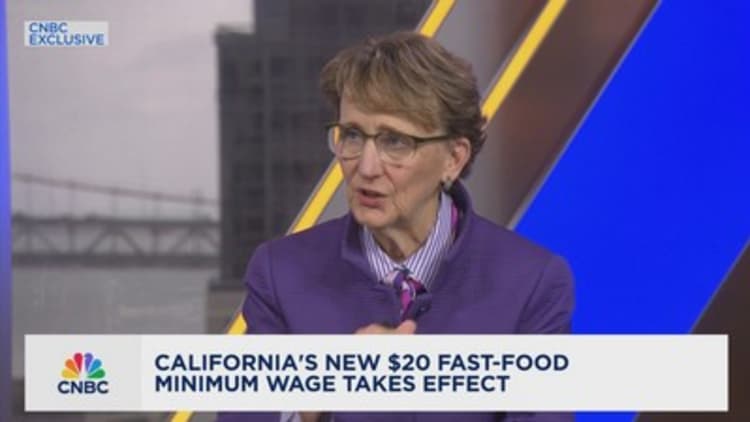An employee wearing protective gloves hands an order to a customer through a drive-thru window at a McDonald’s Corp. restaurant in Oakland, California, U.S., on Thursday, April 9, 2020.
David Paul Morris | Bloomberg | Getty Images
As fast-food chains in California start to pay their workers a higher minimum wage, other business owners across the state are watching to see whether they will have to raise their own pay to compete.
Starting Monday, fast-food workers in California at chains with more than 60 national locations earn $20 an hour, higher than the state’s broader minimum wage of $16 per hour. The new pay floor stems from a state law passed in September, which also establishes a nine-person council that will determine future wage hikes and suggest other guidelines for labor conditions for the industry. There are more than half a million fast food workers in the state, Governor Gavin Newsom said when signing the law in September.
Some affected chains have responded to the mandated wage hike by slashing their workforces and hiking their menu prices. Franchisees for pizza chains Papa John’s, Round Table and Pizza Hut laid off drivers ahead of the deadline. McDonald’s, Wingstop and Chipotle Mexican Grill are among the chains that have said they’ll pass on the higher labor costs to their customers by making their menu items more expensive.
“The consequences are business owners — franchisees who are not large companies, despite what the political supporters of this law have said — these are small businesses and they’re facing now mandated higher costs. And those costs are going to get passed on to the customer and will likely result in fewer jobs,” Matthew Haller, president and CEO of franchisee advocacy group the International Franchise Association, told CNBC.
The law won’t directly touch other restaurants in California — small coffee chains, mom-and-pop diners and upscale steakhouses — but they still could have to adjust their pay as they compete for the same employees. And industries that rely on hourly workers, such as retail and hospitality, may also face pressure to match their wages or risk losing their employees.
“I think we are going to see spillover effects within food service, but beyond that, we should expect to see spillover effects to other industries that are competing for this talent,” Daniel Zhao, lead economist for career site Glassdoor, told CNBC.
The law takes effect as job growth has slowed in the most populous U.S. state. California’s unemployment rate was 5.3% in February, outpacing the U.S. rate of 3.9%, according to the Bureau of Labor Statistics.
California pay is already high
While the new fast-food minimum wage is among the highest in the U.S., California employers are used to paying more for their labor. Roughly three dozen California cities and counties have local minimum wages higher than the state pay floor of $16 an hour.
Even when it is not mandated, restaurants usually find themselves paying more than the minimum wage to attract hourly workers. For years, the industry has struggled with a labor crunch as teens seek out internships instead of restaurant jobs and older workers decamp for other industries with better working conditions and benefits.
The average wage for hourly food service workers in California before the law took effect was $17.89 an hour, according to self-reported Glassdoor data from Oct. 1 to March 28. But only 22% of the state’s hourly restaurant workers were making at least $20 an hour in that time.
The pay hike will have a bigger effect on fast-food joints in areas with lower costs of living, like Fresno, according to Zhao. In major metropolitan areas, the gap between prior pay rates and the new minimum wage is likely smaller.
For example, at Andytown Coffee Roasters in San Francisco, non-tipped employees already make more than $20 an hour, according to owner and CEO Lauren Crabbe. She said she’s “personally thrilled” that fast-food workers for large chains will earn a higher wage in California, though she thinks the legislature missed an opportunity to target giants in other industries, like retail.
“If a multinational company making millions in profit cannot afford to pay the people making their product and serving their customers at least $20 [an hour] in 2024, then they do not have a viable business model,” Crabbe said.
The chief executive of the Cheesecake Factory isn’t sweating the wage hike, either. As a full-service restaurant chain, the company won’t be obligated to pay its California workers $20 an hour. But CEO Matthew Clark said on the company’s earnings call in February that the chain’s tipped positions already make much more, and he believes that’s the case for fast-food workers, too.
“Many of the California [quick-service restaurant] urban locations are already paying $19 and $20,” he said. “We believe that’s partly why they agreed to do it in the first place.”
Businesses outside of the restaurant industry are also eyeing the wage increase for fast food workers.
Jennifer B. Perez runs Growing Roots in Long Beach. The company has 13 employees and has been in business since 2002, designing, installing and maintaining indoor plants for commercial and residential clients.
Perez monitors hikes in industries outside of her own to remain competitive. She gave workers raises this year ahead of the fast-food hike. Workers without experience are making $19 an hour, she said, on the lowest end of her payscale and more than two dollars above the local minimum. They also have paid time off, vision, dental and health insurance.
“It’s a ripple effect, because I’m not part of that industry,” Perez told CNBC of the fast-food increase. “I’m always over minimum wage, but since that keeps increasing and increasing, and it’s a 25% increase from $16 to $20, it’s definitely something to think about.”
Like many business owners, Perez has to think about how inflation affects both her company’s labor costs and her clients’ budgets.
“Most small businesses can’t just do a straight 25% increase across the board, or price increases across the board,” she said.
Advocates prepare to go bigger
From start to finish, the California law, which was backed by the Service Employees International Union, has been controversial.
The restaurant industry fought back against the initial incarnation, signed into law by Gov. Gavin Newsom more than a year ago, by gathering enough signatures for a referendum to make California voters decide on the matter. The SEIU responded by backing a bill that would impose joint-employer liability on franchised businesses, holding franchisors like McDonald’s responsible for labor infractions committed by their franchisees. The two sides came to a deal in September, resulting in the new law and doing away with the joint-employer provisions.
Newsom came under fire in February after Bloomberg reported that a carve-out for restaurants that bake their own bread on premise benefitted the governor’s donor Greg Flynn, owner of the Panera Bread franchisee Flynn Restaurant Group. Newsom’s office denied the story and said that Panera would be required to pay its workers at least $20 an hour. Flynn later said that all his California locations will raise their pre-tip wages to $20 an hour or higher, effective Monday.

After one contentious victory, the SEIU is gearing up for more fights for similar raises for fast-food workers in other states. SEIU President Mary Kay Henry told CNBC that New York, Washington and Illinois are all future potential battlegrounds.
“It’s taken us 10 years to get to this table. And [the workers] feel like they’re going to have a voice on the job that they’ve never been able to experience before,” Henry said.
California will test how the sector-specific minimum wage affects workers, their employers and the broader labor market. Fast-food chains, industry experts and economists will be watching to see if the gloomy predictions for job losses come to pass – or if higher pay comes with benefits even for the businesses dispensing the wages.
Glassdoor’s Zhao said the $20 wage could lure back some of the workers who left their restaurant jobs to work at an Amazon warehouse or to drive for Uber. Plus, those fast-food workers will now have more money in their pocket.
“Folks who are earning more money can also spend more money that gets re-injected into the economy,” he said.





















Discussion about this post